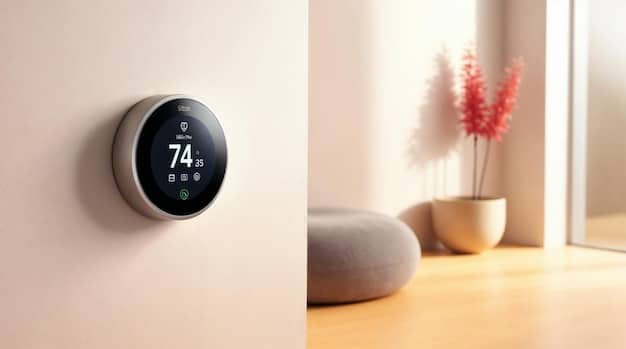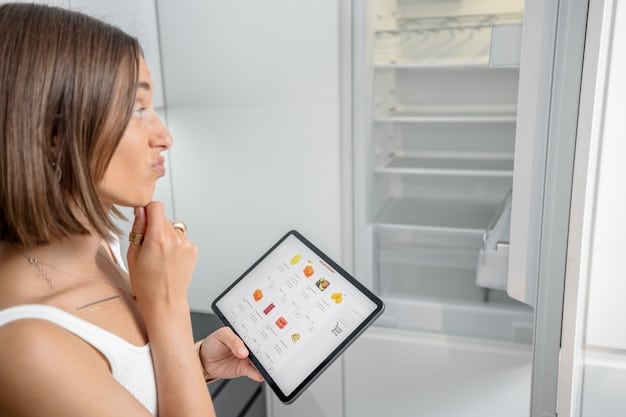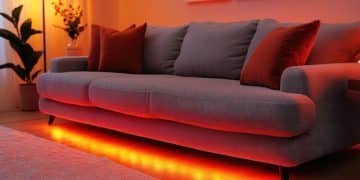Smart Home Accessibility: Transforming Homes for People with Disabilities

Smart home accessibility involves integrating technology that enhances independence and safety for individuals with disabilities by incorporating devices like voice-controlled systems, automated lighting, and smart appliances, creating a more inclusive and manageable living environment.
Creating a comfortable and safe home is a priority for everyone. However, for people with disabilities, this can present unique challenges. That’s where smart home accessibility comes in, offering innovative solutions to transform your living space into a more inclusive and manageable environment.
Understanding Smart Home Accessibility
Smart home accessibility refers to the use of technology to make homes more usable and accessible for people with disabilities. This involves incorporating devices and systems that automate tasks, improve safety, and enhance independence, addressing a wide range of needs.
By leveraging the power of automation and connectivity, even simple changes can have a significant impact on improving and increasing the quality of life for individuals with disabilities. Let’s explore what makes a home truly accessible.
The Core Principles of Accessible Smart Homes
Accessible smart homes prioritize ease of use, safety, and independence. These homes should be designed to cater to the specific needs of the residents, ensuring they can navigate their environment without unnecessary obstacles.
- User-Centric Design: Tailoring technology to meet individual needs and preferences.
- Automation: Automating tasks to reduce physical strain and increase convenience.
- Safety and Security: Implementing features that enhance safety, such as emergency alerts and monitoring systems.
Accessibility also means providing control options like voice commands, touch screens, and mobile apps that are easy to navigate and understand. It’s about making technology an enabler, not a barrier.

Benefits of Smart Home Accessibility
The advantages of an accessible smart home are extensive, enhancing many facets of daily living and fostering greater independence and self-sufficiency among individuals with disabilities.
- Enhanced Independence: Performing tasks without assistance, fostering a greater sense of autonomy.
- Increased Safety: Reducing the risk of accidents with features like automated lighting and emergency alerts.
- Improved Comfort: Adjusting environmental controls for optimal comfort, such as temperature, lighting, and blinds.
Ultimately, smart home accessibility not only simplifies daily life but also contributes to an individual’s overall well-being and sense of control, creating a supportive and nurturing home environment.
Key Technologies for Smart Home Accessibility
Several key technologies play a crucial role in transforming a standard home into an accessible smart home: voice control systems, automated lighting and shading, and smart appliances. Each offers unique benefits that cater to various needs.
These technologies, when integrated thoughtfully, create a holistic smart home experience that enhances both functionality and comfort, making daily living more manageable and enjoyable.
Voice Control Systems
Voice control systems are central to accessible smart homes, enabling users to operate numerous devices with spoken commands. This technology is particularly beneficial for individuals with mobility limitations.
- Hands-Free Control: Adjusting lights, thermostats, and appliances using voice commands.
- Integration with Smart Assistants: Compatibility with popular platforms like Amazon Alexa and Google Assistant.
- Customizable Commands: Setting up personalized commands to fit individual preferences.
Voice control systems promote independence and safety by removing the need for physical interaction with devices, making it easier for individuals with disabilities to manage their home environment.
Automated Lighting and Shading
Automated lighting and shading enhance comfort and improve safety in accessible smart homes. Motion-activated lights can prevent falls, while automated shades can regulate sunlight exposure.
- Motion-Activated Lighting: Automatically turning on lights in response to movement, reducing the risk of accidents.
- Remote Control of Shades: Adjusting window coverings for optimal light and privacy.
- Energy Efficiency: Reducing energy consumption through automated adjustments based on natural light levels.
These technologies not only make homes more functional but also contribute to energy savings and environmental sustainability.
Smart Appliances
Smart appliances simplify household tasks, making them more accessible and manageable for people with disabilities. From refrigerators to washing machines, these devices offer features that enhance usability.
- Remote Monitoring: Managing appliance functions remotely via smartphone or tablet.
- Voice-Activated Controls: Operating appliances with voice commands, enhancing ease of use.
- Smart Features: Receiving notifications for maintenance or when tasks are completed.
Smart appliances are designed to make everyday tasks more straightforward, fostering greater independence and control over one’s living environment.

Designing an Accessible Smart Home
Creating an accessible smart home requires careful planning and consideration of individual needs. The design process should focus on addressing specific challenges and incorporating technology thoughtfully.
By prioritizing user-centric design and incorporating the right technologies, homes can be transformed into supportive environments that promote independence and well-being.
Assessing Individual Needs and Requirements
The initial step in designing an accessible smart home is to assess the specific needs and requirements of the resident. This involves understanding their physical capabilities, limitations, and preferences.
- Physical Limitations: Identifying mobility, vision, or hearing challenges.
- Daily Routines: Understanding daily activities and tasks that need to be simplified.
- Personal Preferences: Considering individual likes and dislikes regarding technology and design.
A thorough assessment ensures that the final design aligns with the resident’s unique requirements, resulting in a home that truly enhances their quality of life.
Integrating Technology Thoughtfully
Thoughtful integration of technology is crucial for creating a functional and accessible smart home. This involves selecting devices and systems that seamlessly integrate with each other and are easy to use.
It’s important to avoid overcomplicating the environment with unnecessary gadgets. Instead, focus on solutions that genuinely address real-life needs.
By prioritizing simplicity, reliability, and user-friendliness, the technology can enhance independence and safety without becoming a burden.
Creating an accessible smart home is about more than just installing gadgets—it’s about crafting a personalized environment that fosters independence, safety, and comfort for individuals with disabilities.
Ensuring Easy Navigation and Control
Easy navigation and control are essential components of an accessible smart home. Placement of devices and control panels should be strategic, ensuring accessibility from various locations.
Consider the placement of key control devices to ensure they are accessible in all of the areas that you would like to use them. Think about where you will be spending the most time in the home to make sure that you are near those key components.
Consistency in control schemes also plays a vital role. Whether using voice commands, touch screens, or mobile apps, a unified interface reduces the learning curve and promotes ease of use.
Implementation and Installation Tips
Proper implementation of smart home technology is essential for creating an accessible environment. Professional installation, wireless vs. wired systems, and compliance with accessibility standards are key factors to consider.
By focusing on these aspects, homeowners can ensure that their smart home investments are both effective and sustainable, providing long-term benefits for individuals with disabilities.
Professional Installation vs. DIY
Deciding between professional installation and a do-it-yourself (DIY) approach depends on individual skills, knowledge, and the complexity of the project. Professional installation offers expertise and ensures proper setup, while DIY can save costs.
For individuals with limited technical skills or complex accessibility needs, professional installation is generally recommended. Experts can assess the home environment, suggest appropriate technologies, and ensure seamless integration.
While DIY can be a cost-effective option, it requires thorough research, technical proficiency, and patience. Before embarking on a DIY project, assess your skills and the complexity of the task at hand to make an informed decision.
Wireless vs. Wired Systems
The choice between wireless and wired systems impacts the reliability and flexibility of a smart home. Wireless systems offer ease of installation and scalability, while wired systems provide enhanced stability and security.
Wireless systems use Wi-Fi or other wireless protocols to communicate between devices, making them easier to install and reconfigure. However, they can be susceptible to interference and security vulnerabilities.
Wired systems, on the other hand, require running cables throughout the home, but they offer more reliable connections and enhanced security. The choice depends on specific needs, budget, and the desired level of reliability.
Adhering to Accessibility Standards
Compliance with accessibility standards ensures that smart homes are designed to meet the needs of individuals with disabilities. Standards such as the Americans with Disabilities Act (ADA) provide guidelines for creating inclusive environments.
ADA standards cover a wide range of considerations, including accessible routes, reach ranges, and control mechanisms. Adhering to these standards ensures that smart homes are usable and safe for people with diverse abilities.
By following accessibility standards, homeowners can create environments that promote independence, safety, and dignity for all residents.
Implementing smart home technology requires careful planning and attention to detail. Focus on professional installation, consider wireless vs. wired systems, and ensure compliance with accessibility standards to achieve accessible solutions.
Cost and Funding Options
The cost of smart home accessibility can vary widely depending on the technologies and adaptations required. Understanding the cost implications and exploring funding options is crucial for making these improvements affordable.
By carefully evaluating the expenses and identifying available assistance programs, homeowners can make informed decisions and create accessible smart homes that are within their financial reach.
Estimating the Cost of Smart Home Accessibility
Estimating the cost of smart home accessibility involves assessing the required technologies, installation expenses, and ongoing maintenance fees. Costs can range from a few hundred dollars for simple upgrades to several thousand for comprehensive systems.
Voice control systems, smart lighting, and smart appliances can be relatively affordable, while complex installations such as automated lifts or specialized sensors may incur higher costs.
Considerations include the initial investment, energy consumption, and potential savings on caregiving expenses. A thorough cost analysis ensures that the smart home investments align with the homeowner’s budget and long-term goals.
The cost of smart home accessibility technology can vary greatly and is largely dependent on the different types of technology integrations that you will be integrating into your home overall, it can be a large or small investment into the technology.
Exploring Funding Opportunities and Grants
Various funding opportunities and grants are available to assist homeowners with the cost of smart home accessibility. Government programs, nonprofit organizations, and disability advocacy groups offer financial assistance.
- Government Programs: State and federal initiatives that provide grants or low-interest loans for home modifications.
- Nonprofit Organizations: Charitable organizations that offer financial assistance and resources for individuals with disabilities.
- Disability Advocacy Groups: Organizations that advocate for the rights of people with disabilities and provide information on funding opportunities.
Researching and applying for these programs can significantly reduce the financial burden of creating an accessible smart home.
Tax Incentives and Deductions
Tax incentives and deductions can further offset the cost of smart home accessibility improvements. Homeowners may be eligible for tax credits or deductions for medical expenses or home modifications that enhance accessibility.
Consult with a tax professional to understand the available tax benefits and how to claim them. Tax incentives can provide significant financial relief, making it more affordable to invest in smart home accessibility technologies.
Understanding the cost implications and exploring funding options is essential for homeowners seeking to create accessible smart homes. Take time to assess your eligibility and gather information regarding the available funding opportunites to reduce costs.
Future Trends in Smart Home Accessibility
The field of smart home accessibility is continuously evolving, driven by technological advancements and changing societal needs. Emerging trends such as AI-driven personalization, enhanced sensor technologies, and integration with healthcare systems promise to further transform how homes support individuals with disabilities.
The future of smart home accessibility is exciting, with the potential to create more personalized, intuitive, and supportive living environments that truly enhance independence and well-being.
AI-Driven Personalization
Artificial intelligence (AI) is playing an increasingly significant role in smart home accessibility by enabling personalized experiences tailored to individual needs. AI algorithms can learn user preferences and automate tasks accordingly.
For example, AI-powered systems can adjust lighting, temperature, and entertainment settings based on the resident’s habits and preferences. AI also can provide personalized recommendations for assistive devices and services.
AI-driven personalization has the potential to create smart homes that are not only accessible but also highly intuitive and responsive to the unique needs of their residents.
Enhanced Sensor Technologies
Enhanced sensor technologies are improving the ability of smart homes to monitor and respond to the needs of individuals with disabilities. Advanced sensors can detect falls, monitor vital signs, and alert caregivers in case of emergencies.
These sensors can be integrated into wearable devices, home appliances, and environmental control systems, providing real-time data and proactive support. Enhanced sensor technologies improve safety and peace of mind, enabling individuals to live more independently.
Another great improvement that could come about in the future would be more accurate health tracking. Think things like, being able to identify if someone has fallen and been unable to get up to notify emergency personnel.
Integration with Healthcare Systems
Integration with healthcare systems enhances the potential of smart homes to provide comprehensive support for individuals with disabilities. Smart home devices can be connected to healthcare providers, enabling remote monitoring and telemedicine services.
This integration allows healthcare professionals to track vital signs, monitor medication adherence, and provide virtual consultations, improving access to healthcare and promoting better health outcomes. The convergence of smart home technology and healthcare holds the promise of transforming how we care for individuals with disabilities.
| Key Aspect | Brief Description |
|---|---|
| ♿ Independence | Smart home tech promotes autonomy for people with disabilities. |
| 💡 Key Technologies | Voice control, automated lighting, and smart appliances enhance accessibility. |
| 💰 Funding | Grants, tax incentives, and financial aid opportunities exist. |
| 🤖 Future Trends | AI personalization and advanced sensor tech are paving the way. |
[Frequently Asked Questions]
▼
Smart home accessibility refers to using technology to make homes more usable for people with disabilities.
▼
Voice control allows individuals control of various devices using voice commands to make life easier.
▼
There are various state and federal funding programs that can help with financial support for smart homes.
▼
AI driven personalization is only the tip of the iceberg, as the technology continues to grow and improve everyday life.
▼
Wired systems provide a stable connection, while wireless systems are easier to install, it all boils down to preference.
Conclusion
Smart home accessibility represents a transformative approach to creating inclusive and supportive living environments for individuals with disabilities. By incorporating the right technologies and focusing on user-centric design, homes can foster independence, enhance safety, and improve overall quality of life. As technology continues to advance, the potential for smart home accessibility to make a positive impact on the lives of people with disabilities is greater than ever.





